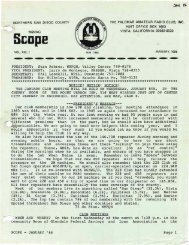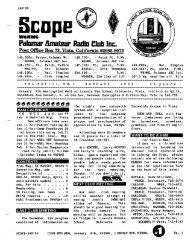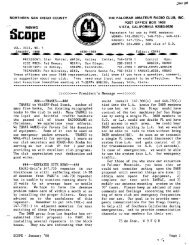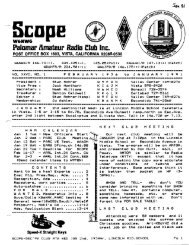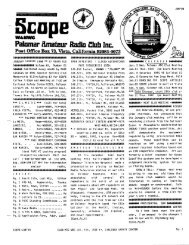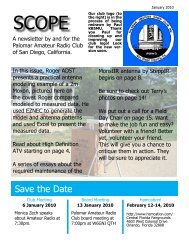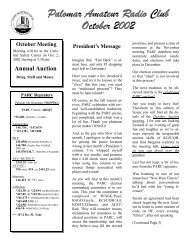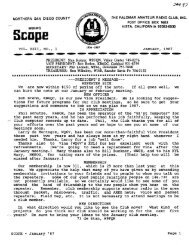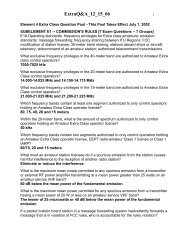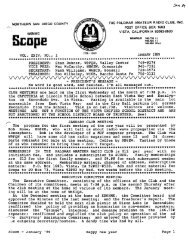Create successful ePaper yourself
Turn your PDF publications into a flip-book with our unique Google optimized e-Paper software.
· I d' [!l .. 'edll' I<br />
With the above in mind, please abide<br />
by the following simple guidelines on<br />
the repeater:<br />
t. When you first "sign on" the repeater,<br />
alone (as when you first announce your<br />
presence and the repeater is quiet) or<br />
joining a conversation, you must ideo-<br />
statIon or te ecomman station, must translDlt Its asSign ca Sign at east tifY with your ENTIRE call sign. Not<br />
transmit its assigned call sign on its once per hour during such transmissionsjust<br />
the suffix, not just the prefix, not<br />
transmitting channel at the end of each<br />
communication, and at least every ten (e) When the operator license class held<br />
your name alone because you think your<br />
voice is recognizable, or any other<br />
minutes during a communication, for the by the control operator exceeds that of shortened version. You must identifY<br />
purpose of clearly making the source of the station licensee, an indicator consisting<br />
with your entire call sign.<br />
the transmissions from the station known<br />
to those receiving the transmissions. No<br />
station may transmit unidentified communications<br />
or signals, or transmit as the<br />
station call sign, any call sign not authorized<br />
to the station.<br />
(b) The call sign must be transmitted<br />
with an emission authorized for the<br />
transmitting channel in one ofthe followmg<br />
ways:<br />
(1) By a CW emission. When keyed by<br />
an automatic device used only for identification.<br />
the speed must not exceed 20<br />
words per minute;<br />
(2) By a phone emission in the English<br />
language. Use of a standard phonetic<br />
alphabet as an aid for correct station<br />
identification is encouraged;<br />
(3) By a R TTY emission using a specitied<br />
digital code when all or part of the<br />
communications are transmitted by a<br />
RTTY or data emission;<br />
(4) By an image emission conforming to<br />
the applicable transmission standards, eithl.'T<br />
color or monochrome, of§73.682(a)<br />
of the FCC Rules when all or part of the<br />
communications are transmitted in the<br />
same image emission.<br />
(c) One or more indicators may be ineluded<br />
with the call sign. Each indicator<br />
must be separated from the call sign by<br />
the slant mark (I) or by any suitable word<br />
that denotes the slant mark. If an indicatOT<br />
is self-assigned, it must be included<br />
before, after, or both before and after, the<br />
call sign. No self-assigned indicator may<br />
conflict with any other indicator spec i<br />
of the call sign assigned to the<br />
control operator's station must be included<br />
after the call sign.<br />
(f) When the control operator who is<br />
exercising the rights and privileges authorized<br />
by §97.9(b) of this Part, an<br />
indicator must be included after the call<br />
sign as follows:<br />
(I) For a control operator who has reo<br />
quested a license modification from<br />
Novice to Technician Class: KT;<br />
(2) For a control operator who has requested<br />
a license modification from<br />
Novice or Technician Class to General<br />
Class: AG;<br />
(3) For a control operator who has requested<br />
a license modification from<br />
Novice, Technician. or General Class<br />
operator to Advanced Class: AA; or<br />
(4) For a control operator who has reo<br />
quested a license modification from<br />
Novice, Technician, General, or Advanced<br />
Class operator to <strong>Amateur</strong> Extra<br />
Class: AE.<br />
(g) When the station is transmitting under<br />
the authority of§97.1 07 ofthis part,<br />
an indicator consisting of the appropriate<br />
letter-numeral designating the station<br />
location must be included before<br />
the call sign that was issued to the<br />
station by the country granting the license.<br />
For an amateur service license<br />
granted by the Government of Canada,<br />
however, the indicator must be included<br />
after the can sign. At least once during<br />
each intercommunication, the identification<br />
announcement must include the geo<br />
F or those of you quick on the trigger,<br />
please pause after pushing the PTT<br />
button so that you are fully into the<br />
repeater before starting to 10.<br />
2. Once you are on the repeater, identifY <br />
at a minimum once every 10 minutes, <br />
and when ending your transmissions (as <br />
in when signing oft). <br />
3. PARC policy is that repeater conver<br />
sations be guided by the rule ofcommon <br />
decency. If you would talk to your <br />
mother or children with the language <br />
you are using, you are probably OK. <br />
73 deNN3V <br />
ographicallocation as nearly as possible<br />
by city and state, commonwealth or<br />
possession.<br />
fied by the FCC Rules or with any prefix<br />
assigned to another country.<br />
(d) When transmitting in conjunction<br />
with an event of special significance, a<br />
station may substitute for its assigned<br />
call sign a special event call sign as<br />
shown for that station for that period of<br />
time on the common data base coordinated,<br />
maintained and disseminated by<br />
the speciaJ event call sign data base coordinators.<br />
Additionally, the station must<br />
No. County ARES<br />
In our last ARES meeting, we de<br />
cided to hold every other meeting on a <br />
net, starting with October 18, <strong>2000</strong> at <br />
7:00 PM, using the 147.130 repeater as <br />
suggested. <br />
The November meeting will be held ~<br />
at the Vista No. ) Fire Station as usual,<br />
and the December will be on the net. 73<br />
KF6GOFNorm.<br />
Electrocutions<br />
63% of total fatalities in the construction<br />
industry are due to electrocution.<br />
The electrocutions arise from a<br />
multitude ofdifferent hazards.<br />
Most commonly, workers come in<br />
contact with overhead electrical lines,<br />
either directly or through a device such<br />
as an aluminum ladder. Workers have<br />
been killed drilling holes in concrete, not<br />
realizing that they are in danger of corn~<br />
ing into contact with live wires.<br />
Just last week OSHA proposed a<br />
$70,000 fine on a Florida construction<br />
firm for an electrocution involving overhead<br />
lines.<br />
www.cenformity-apd.te.collllosll.-electro<br />
000811.'" de N6Kl



